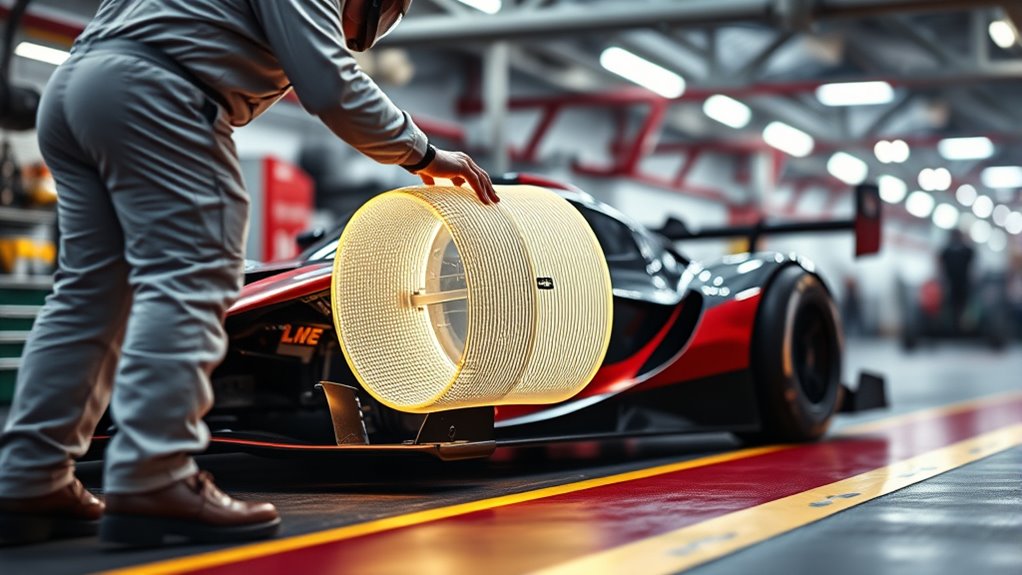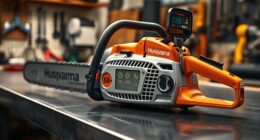Using 3D-printed spares at the track can dramatically cut your downtime by enabling quick on-site repairs and custom part creation. You can produce critical components like brackets, gears, or sensor housings instantly, avoiding shipping delays. Durable materials like carbon fiber or plastics guarantee safety and performance. By adopting this technology, you keep your team ready to race and reduce costs. Keep exploring how this innovative solution can transform your racing operations.
Key Takeaways
- 3D printing enables on-site production of critical spare parts, eliminating shipping delays and reducing repair times during races.
- Customizable 3D-printed components like brackets and gears allow quick replacements, minimizing trackside downtime.
- Rapid prototyping with 3D printing helps teams address unforeseen issues swiftly without waiting for traditional manufacturing.
- Material advancements, such as carbon fiber and metals, ensure printed parts withstand racing conditions, enhancing safety and durability.
- Integrating AI-driven design optimization and quality control streamlines production, boosting efficiency and reliability at the track.
The Evolution of Spare Part Manufacturing in Motorsport
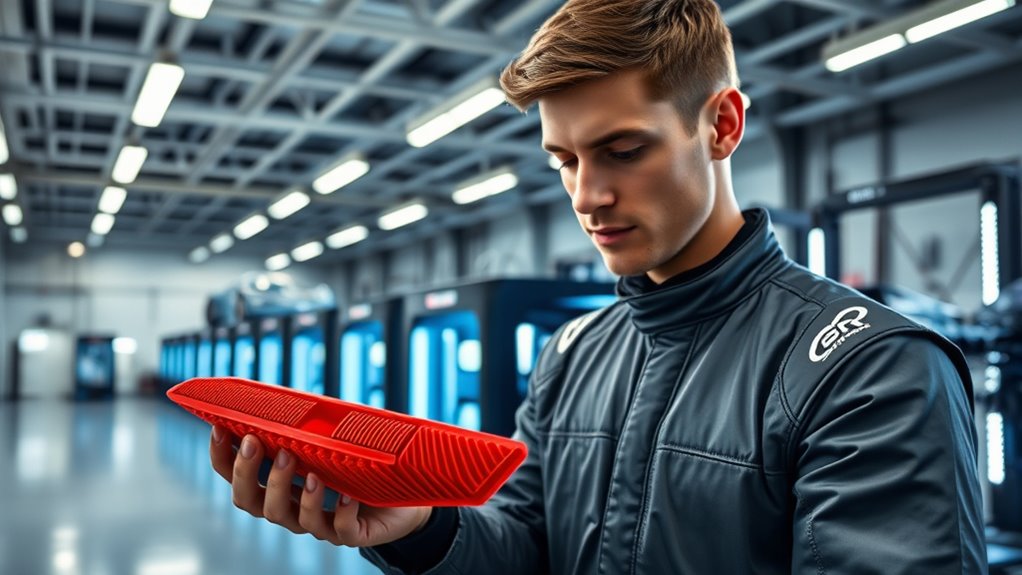
The evolution of spare part manufacturing in motorsport has been driven by rapid technological advances and the constant demand for faster, more efficient repairs. In the past, teams relied on traditional manufacturing methods, which often meant waiting weeks for custom parts. As race schedules tightened, the need for quick turnaround times grew. This pushed manufacturers to innovate, adopting new materials and techniques to produce parts faster. CNC machining and rapid prototyping helped reduce lead times, but these methods still had limitations. Today, the focus is shifting toward additive manufacturing, or 3D printing, which allows you to create complex geometries quickly and on demand. This shift has revolutionized how teams approach spare parts, enabling faster repairs and minimizing downtime during races. Additionally, the ability to customize parts through 3D‑printed spares ensures optimal performance tailored to specific needs.
How 3D Printing Accelerates On-Site Repairs
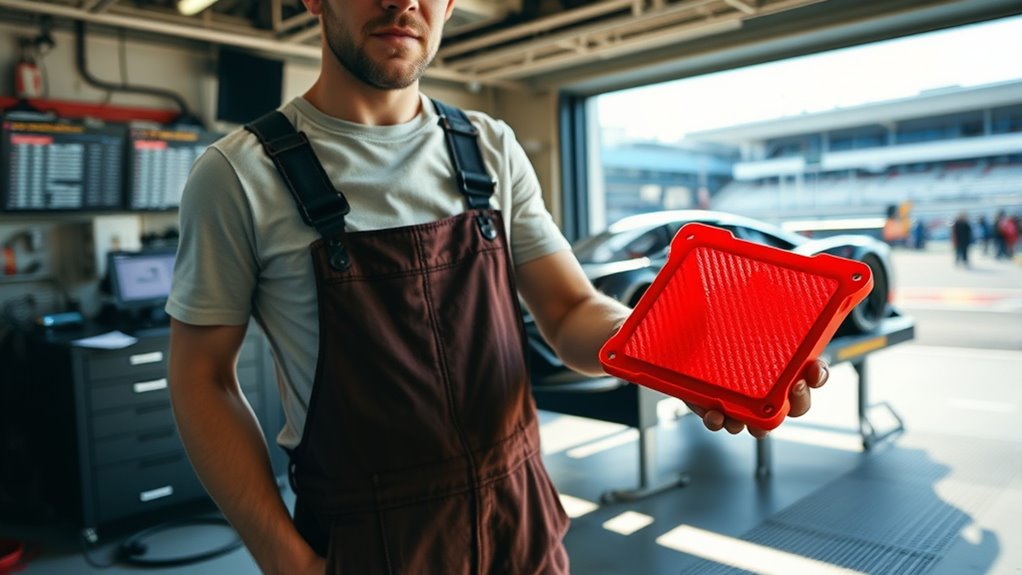
As motorsport teams adopt 3D printing for spare parts, they’re able to perform on-site repairs with unprecedented speed. Instead of waiting days for parts from suppliers, you can produce critical components right at the track. This eliminates shipping delays and reduces downtime markedly. With a portable 3D printer and the right materials, you can quickly create replacement brackets, clips, or small gears on demand. This agility means you can respond instantly to unexpected failures, keeping your vehicle on track longer. Plus, 3D printing allows for rapid prototyping of custom parts, so you can adapt to unforeseen issues without waiting for traditional manufacturing. Incorporating cost-effective solutions like 3D printing streamlines repairs, minimizes delays, and ensures you stay competitive during race day.
Types of Components Suited for 3D Printing

You’ll find that customizable engine parts benefit from 3D printing’s flexibility, allowing quick tweaks and on-demand production. Lightweight chassis components can be created to reduce overall weight without sacrificing strength. These types of components show how 3D printing offers practical solutions for both performance and efficiency. Additionally, decorative elements such as custom insignias or trim pieces can be fabricated to personalize the vehicle’s appearance while maintaining durability.
Customizable Engine Parts
Since 3D printing allows for rapid prototyping and customization, it’s particularly well-suited for producing engine parts that benefit from tailored designs or complex geometries. You can create custom fuel nozzles, intake manifolds, or sensor housings that fit precisely within your engine’s unique setup. Complex internal channels or cooling features, which are difficult to machine traditionally, become feasible with additive manufacturing. This flexibility lets you optimize airflow, improve performance, and reduce weight. Additionally, you can quickly iterate designs based on testing results, saving time and costs. For racing teams, 3D-printed engine components mean faster repairs and personalized solutions that give you a competitive edge. Overall, it empowers you to craft specialized parts that boost efficiency and reliability on the track.
Lightweight Chassis Components
Have you considered which chassis components benefit most from 3D printing? Lightweight parts are perfect candidates, as reducing weight improves performance without sacrificing strength. 3D printing allows you to quickly produce custom, complex shapes that traditional manufacturing can’t easily create. For example, you might print:
- Seat brackets that need to be both strong and light
- Aerodynamic fairings tailored to specific track conditions
- Support brackets for suspension or body panels
These components can be designed for ideal weight savings, tested rapidly, and replaced instantly if damaged. Using 3D printing for such parts minimizes downtime and allows for quick design iterations, giving you a competitive edge on the track.
Materials Used in 3D-Printed Race Car Spares
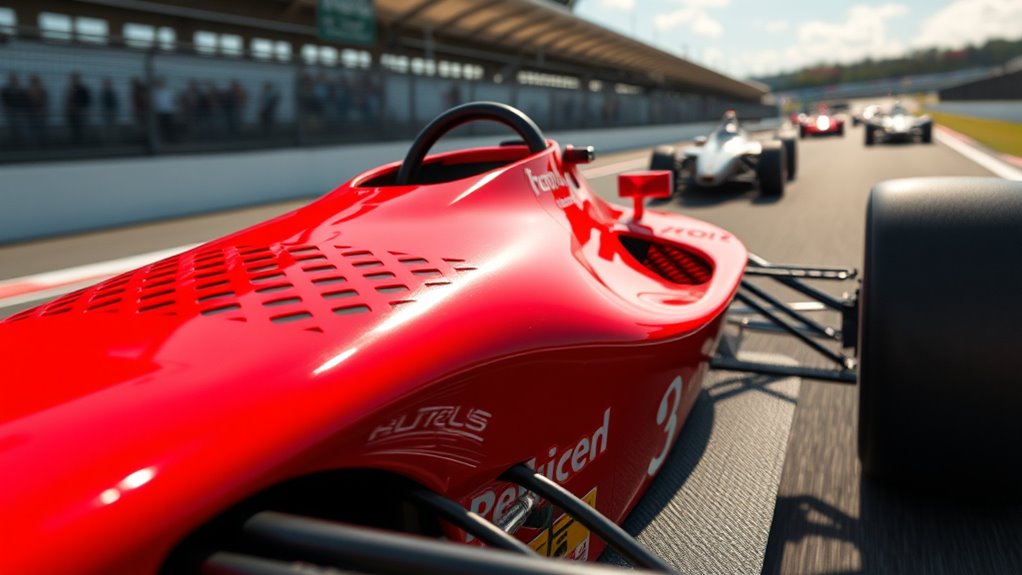
Materials used in 3D-printed race car spares are chosen for their strength, durability, and lightweight properties. You need parts that can withstand high stress without adding weight, so engineers often select advanced thermoplastics, composites, and metals. These materials deliver the resilience required for racing conditions, ensuring safety and performance. For example, Volkswagen Tuning often incorporates lightweight materials like carbon fiber to optimize performance.
| Material | Strength | Weight |
|---|---|---|
| Carbon Fiber | Exceptional strength | Very light |
| ABS Plastic | Good durability | Light |
| Titanium | Superior durability | Moderate |
This combination of materials empowers you to replace parts quickly, cut down on downtime, and push your vehicle to its limits—giving you the competitive edge you need on the track.
Case Studies: Wins With 3d-Printed Parts
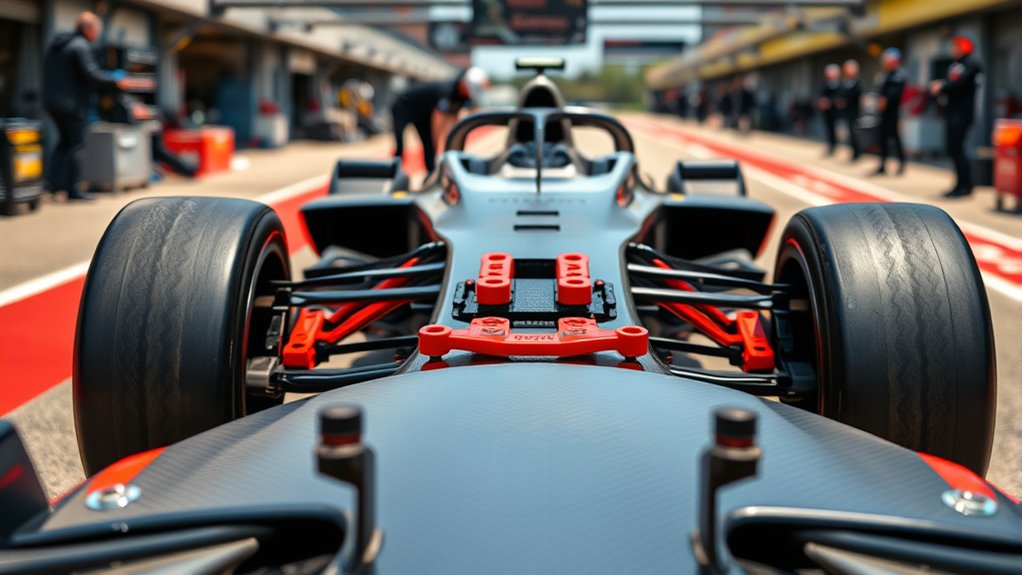
Across the racing world, teams are turning to 3D-printed parts to secure remarkable victories. These case studies highlight how quick, on-demand manufacturing can make the difference between winning and losing. For example, a Formula 3 team printed a custom brake duct that reduced replacement time by 70%, ensuring faster pit stops. In another instance, a rally car used 3D-printed suspension components to fix damage on the fly, avoiding a costly race stop. Ultimately, a NASCAR team printed a unique airflow bracket that improved aerodynamics, boosting performance. Additionally, the ability to manage data privacy and cookies effectively ensures that teams can use digital tools securely during critical moments.
Challenges and Limitations of 3D Printing in Racing

While 3D printing offers significant advantages in racing, it also faces notable challenges that can hinder its widespread adoption. One major issue is material limitations; not all 3D printable materials can withstand the extreme conditions of racing environments, such as high temperatures and stress. Additionally, the layer-by-layer printing process can result in weaker parts if not carefully optimized, potentially leading to failures during critical moments. Speed is another concern—while some printers are fast, producing complex parts still takes time, which may not suit urgent track needs. Quality consistency can also be problematic, as variations between prints can affect performance and safety. These challenges require careful consideration and ongoing advancements to fully realize 3D printing’s potential in racing. Vetted materials are essential to ensure durability and safety under racing conditions.
Cost Benefits and Return on Investment
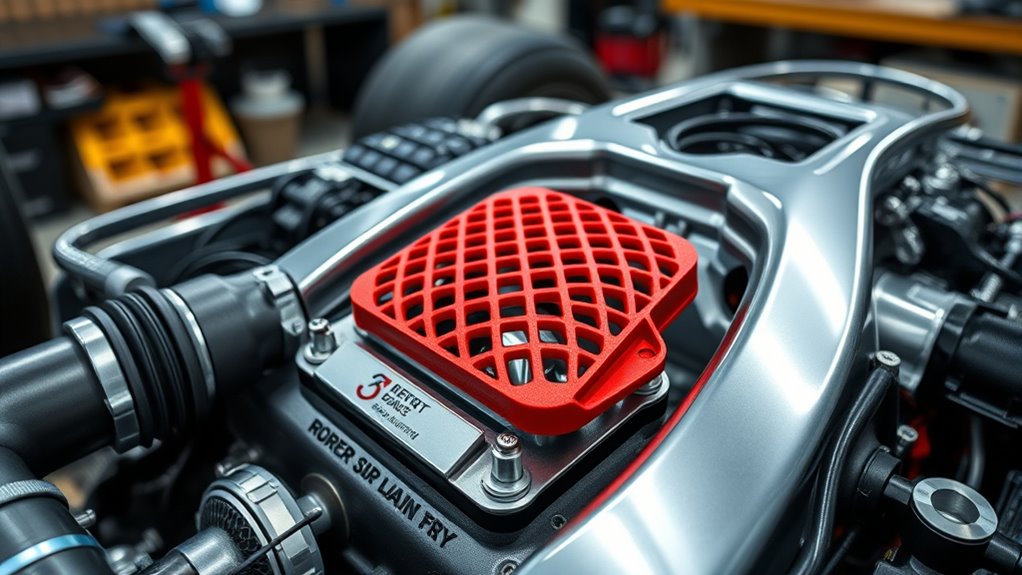
Implementing 3D printing in racing can considerably reduce costs and improve return on investment by enabling rapid prototyping and on-demand part production. This technology cuts expenses related to inventory, shipping, and custom tooling. You can quickly produce spare parts as needed, avoiding delays and costly rush orders. The ability to iterate designs rapidly also minimizes development costs and accelerates the testing process.
- Lower inventory and warehousing expenses
- Reduced lead times and expedited repairs
- Fewer costly third-party manufacturing fees
These benefits translate into more efficient use of your budget, less downtime, and faster race readiness. Overall, 3D printing offers a compelling way to maximize ROI while maintaining high-performance standards on the track.
Future Trends in Rapid Production Technologies

You’ll see advanced materials revolutionize the durability and functionality of 3D-printed spares, making them more reliable than ever. Integration with AI systems will streamline design, production, and quality control, boosting efficiency across industries. These innovations are set to reshape how rapid production meets future manufacturing needs. Additionally, incorporating juice cleansing benefits can inspire sustainable and health-conscious practices within manufacturing workflows.
Advanced Material Innovations
Advancements in material science are driving rapid innovations in 3D printing, enabling you to create stronger, more versatile, and sustainable prototypes and spare parts. New composite materials, such as carbon-fiber-reinforced filaments, offer exceptional strength-to-weight ratios, ideal for high-stress applications. Biodegradable and recyclable plastics reduce environmental impact, aligning with sustainability goals. Additionally, metal 3D printing using advanced alloys allows for durable, heat-resistant components that match or surpass traditionally manufactured parts. These innovations mean you can produce parts with improved mechanical properties, longer lifespan, and lower environmental footprint. Incorporating correct oil into the manufacturing process ensures optimal performance and longevity of 3D-printed components.
Integration With AI Systems
As AI systems become more integrated into 3D printing workflows, they are transforming how rapid production processes are optimized and managed. You can now rely on AI to analyze data, predict failures, and streamline design adjustments in real-time. This integration enables faster decision-making, minimizing errors and reducing lead times for spare parts. AI-driven algorithms can automatically generate ideal print parameters, ensuring consistent quality while saving material and time. You’ll find that AI also enhances inventory management, predicting which spares you’ll need most and reducing excess stock. Additionally, AI can support mental clarity and health by optimizing workflow sequences to reduce human error and improve focus. As a result, your operations become more efficient, responsive, and cost-effective. Embracing AI integration in 3D printing puts you ahead, enabling rapid, reliable production of critical components with minimal downtime.
Implementing 3D Printing in Motorsport Teams
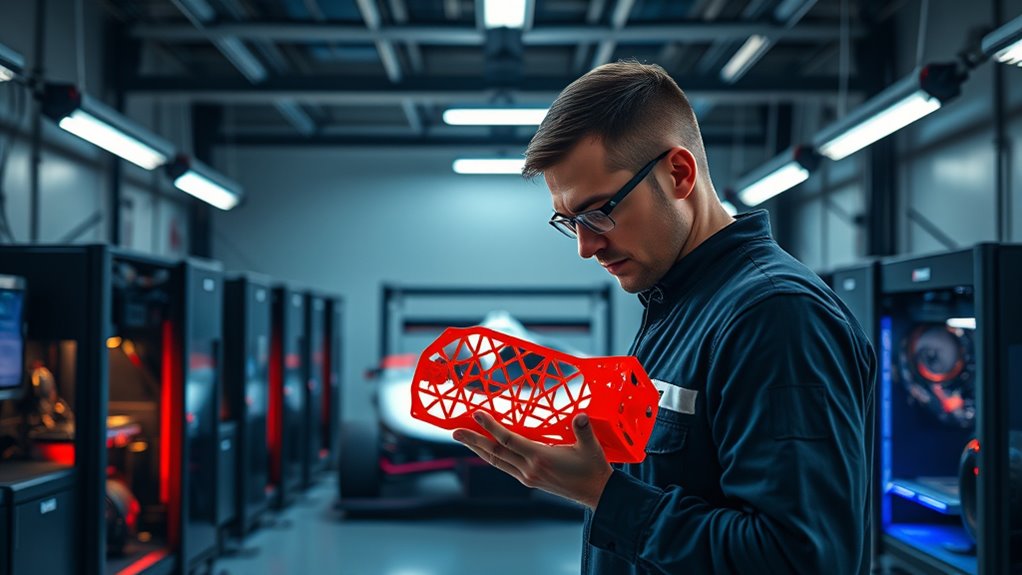
Implementing 3D printing in motorsport teams requires a strategic approach to seamlessly integrate the technology into existing workflows. You need to assess current processes and identify parts that benefit most from rapid prototyping or on-demand manufacturing. Collaborate with engineers and technicians to develop standardized procedures for designing, printing, and testing parts. Invest in training staff to operate 3D printers confidently and troubleshoot issues quickly. Keep in mind, successful implementation also involves establishing quality control measures and maintaining material inventories. Additionally, understanding the importance of cost-effective production can help optimize the manufacturing process and reduce expenses.
Frequently Asked Questions
How Does 3D Printing Impact Race Car Aerodynamics?
You might wonder how 3D printing impacts race car aerodynamics. It allows you to quickly prototype and customize aerodynamic parts, improving airflow and reducing drag. You can make fine adjustments to spoilers, diffusers, and wing components more efficiently. This rapid iteration helps optimize your car’s performance. Plus, 3D printing enables lightweight designs without sacrificing strength, giving you an aerodynamic edge on the track.
Are 3d-Printed Parts Compliant With Motorsport Safety Standards?
You might wonder if 3D-printed parts meet motorsport safety standards. Generally, yes, but it depends on the material and manufacturing process. You need to guarantee the parts are tested and certified according to specific regulations. By working closely with suppliers and adhering to industry standards, you can confidently use 3D-printed components that are safe, reliable, and compliant, helping you stay competitive without compromising safety.
What Is the Typical Turnaround Time for Printing Race Components?
When you ask about turnaround times for printing race components, it’s like comparing a quick pit stop to a full race. Typically, you can get simple parts printed within a few hours, but complex components might take a day or more. Factors like printer speed, material, and part complexity influence this. You’ll find 3D printing offers rapid turnaround, helping you minimize downtime and keep your team competitive.
How Do 3d-Printed Spares Perform Under Racing Conditions?
You’ll find that 3D-printed spares perform impressively under racing conditions, thanks to advanced materials designed for strength and durability. They withstand high stress, heat, and vibrations, making them suitable for real-time use. While they may not replace all traditional parts, they’re a reliable solution for quick replacements and critical components, helping you minimize downtime and keep your race on track.
Can 3D Printing Help Reduce Overall Team Inventory Costs?
Think of 3D printing as your team’s secret weapon, slicing through inventory costs like a hot knife through butter. It lets you produce spare parts on demand, so you avoid stocking up on rarely used items. This flexible approach means less money is tied up in parts gathering dust, and you can quickly adapt to new needs. Overall, 3D printing helps you cut costs and stay agile in a competitive racing environment.
Conclusion
Embracing 3D printing transforms your racing team into a finely tuned machine, where rapid on-site repairs act as the engine’s turbo boost. By cutting downtime and streamlining spare part production, you stay ahead of the pack. As technology accelerates, this innovation becomes your pit crew’s secret weapon—fueling victory and pushing boundaries. The future of motorsport is a race against time, and 3D printing guarantees you’re always in the lead.
